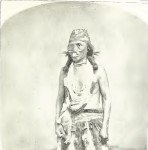Hoopa Valley Sub-agency
Report of Special Agent I. P. Pell on the Indians of Klamath River reservation, Hoopa Valley sub-agency, Humboldt County, California, January 1801.
Names of Indian tribes or parts of tribes occupying said reservation: 1 Klamath River [or properly Outlines and Enroes].
The unallotted area of this reservation is 25,1300 acres, or 40 square miles. This reservation has been surveyed. It was established by executive order of November 16, 1855.
Klamath River reservation, Humboldt County, California, created by executive order November 16, 1855, is carried on the books of the Indian Office. The public land laws of the United States do not apply to public lands until extended over them by specific act of Congress. No agent or United States authority resides on this reservation. It is tributary, however, to the Hoopa Valley sub-agency.
The Klamath reservation Indians now number 80 or 90 and live on the reservation along the Klamath River, from its mouth, where it empties into the Pacific Ocean. As I understand it, the reservation lands are 1 mile wide on each side of the river and running back and up 20 miles. There is but little arable land in its whole extent patches are now and then found of from half au acre to 3 or 4 acres each.
The Indians residing on or about the reservation are personally within the laws and system of the state of California, They are more than usually intelligent and capable. One or two live on the Hoopa Valley reservation, and some have homes near Eureka and Arcata. They work small pieces of land for themselves and do more or less work for the white people. Those living on the reservation also do some work for the white folks, either on farms, ranches, or at placer mining. They live in a comfortable manner in rough wooden huts, which they build for themselves.
From the best information obtainable from several sources it would appear that these Indians desire to live with the settlers, also want more white people to come in and develop the resources of the country adjacent, and in this way furnish more work for them.
These Indians do the finest kind of basket weaving, similar in many respects to the Hoopas, only much finer and more delicate. They are reservation Indians only in the matter of residence. They are entirely self-supporting.
Klamath Indians off Reservations
Report of Captain William Dougherty, First United. States infantry; on the Klamath Indians of California.

There are Klamath Indians living along the river of that name all the way from the lake down to the sea, nearly or quite 200 miles, and on both sides of the river, in. Oregon and California, from Orleans bar to the mouth of the Klamath River, about 70 miles. There are about 1,400 Indians called Klamath; They were formerly known as Cuthacs and Eurocs, and are known as Klamaths only because they live on the Klamath River. They were taken in 1890 by the regular enumerator, seventh district, and reported as 835. They live without assistance from the government, and are peaceable, friendly to the government and the whites, and industrious, though without a reservation or any agricultural land. They all speak English, and many can read and write, though there never has been a school among them. Their staple food is fish and acorns. Many of the young men work in the mines and sawmills, and they constitute the only farm laborers for the whites wherever any farming can be done.
The Matriarchal system does not exist among them, and they have not had a tribal organization for some generations. They have a common law of their own by which their issues and controversies are settled, the enforcement being left always to the aggrieved party and his following. Perpetual bloodshed and enmity between them is the consequence. They mingle freely with the whites, and, the population of this. region being sparse, the white race is being absorbed by the Indian. A few of them, about 100, live on the Klamath reservation. The Klamaths proper live about the Klamath Lakes, in Oregon.
Citations:
- The statements giving tribes, areas, and laws for agencies are from the Report of the Commissioner of Indian. Affairs, UN, pages 434-448. The population is the result of the census.[
]
